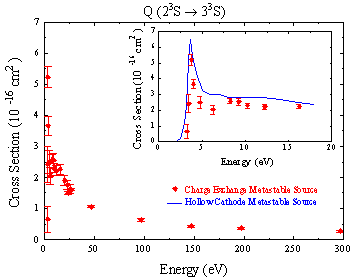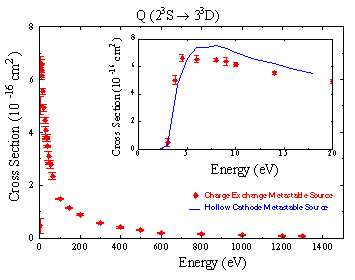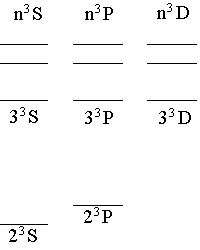III) Excitation out of Metastable Levels of Atoms
B. Helium
Some Sample Results: 33S, 33D
Having performed two seperate experiments, with different methods of absolute calibration, it is interesting to see how the two compare. Here are excitation functions for the 33S and 33D levels: |
 |
Note the excellent agreement in both shapes and magnitudes. The error bars are statistical error only and do not reflect the additional uncertainity from the absolute calibration.
Comparison to Excitation from the Ground State
 Recall again that for excitation out of the 11S ground state:
Recall again that for excitation out of the 11S ground state:
Thus, for excitation out of the 23S metastable state we would expect:
Q(11S-->n1P) Optically allowed series:
Large cross sectionsQ(11S-->n1S) Dipole-forbidden series: Q(11S-->n1D) Smaller cross sections
Q(23S-->n1P) Largest Q(23S-->n3S) Smaller Q(23S-->n3D)
However, this is not the case. For the n=3 (and higher) levels, the largest cross section is for excitation into the 33D level, then the 33S and finally the 33P; opposite of the expected pattern.
| Measured Q(23S-->n3L) cross sections at 10 eV | ||||
| 23S-->n3P | 23S-->n3S | 23S-->n3D | ||
|---|---|---|---|---|
| n=2 | 94 | |||
| n=3 | 1.4 | 2.7 | 6.7 | |
| n=4 | 0.21 | 0.64 | 1.2 | |
| n=5 | 0.25 | 0.39 | ||
| Q in units of 10-16 cm2, with uncertainty of ± 35% | ||||
Part of the explaination of this reversal from the ground state pattern can be traced to the exceptionally large 23P cross section. Let us return to considering the electron-impact excitation process to be similar to an optical absorbtion process. There is a sum rule for optical absorption out of a given level. If the optical oscillator strength is particularly large into one level, then the sum rule limits the optical oscillator strengths for all other levels. While such a strict sum rule does not exist for electron-impact excitation, because the 23S-->23P cross section is so large, it effectively decreases the size of the 23S-->n3P cross sections for n>2.
Comparison of Singlet-to-Triplet
Besides measuring excitation from the 23S metastable level, we have also measured cross sections for excitation out of the 21S metastable level. Let us consider the difference seen between excitation from 23S-->n3L and 21S-->n1L.
Both correspond to the same orbital excitation (1s)(2s) --> (1s)(nl). The only difference is whether the (1s) passive electron has parallel or antiparallel spin.
Q( 23S-->33S) 2.7 Q( 21S-->31S) 3.3 Q( 23S-->33D) 6.7 Q( 21S-->31D) 21 in 10-16 cm 2, at 10 eV
Note that for singlets, there is a much greater difference between excitation into S and D levels as compared to triplets.
references:
Cross sections for electron excitation of the 23S metastable level of He into higher triplet levels Garrett A. Piech, Mark E. Lagus, L. W. Anderson, Chun C. Lin, and M. R. Flannery, Physical Review A 55 (1997) 2842-2856.
Cross sections of electron excitation out of metastable helium levels with a fast metastable target produced via charge exchange Mark E. Lagus, John B. Boffard, L. W. Anderson, and Chun C. Lin, Physical Review A 53 (1996) 1505-1518.
Cross sections for electron excitation out of the metastable levels of helium into the higher singlet levels Ronald B. Lockwood, Francis A. Sharpton, L. W. Anderson, and Chun C. Lin, Physics Letters A 166 (1992) 357-360.
 |
 |
 |